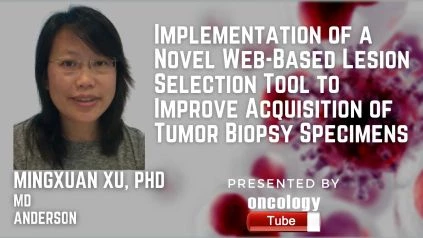Mingxuan Xu, Ph.D., Research Scientist at MD Anderson speaks about the Implementation of a Novel Web-Based Lesion Selection Tool to Improve Acquisition of Tumor Biopsy Specimens.
Link to Naing Tool:
https://doi.org/10.36401/JIPO-21-X1
Link to Article:
https://meridian.allenpress.com/innovationsjournals-JIPO/article/4/2/45/465080/Implementation-of-a-Novel-Web-Based-Lesion
SUMMARY:
The first paragraph is an introduction.
Biopsy specimens must yield sufficient tumor tissue, and sequential biopsy specimens should sample a clear site, for the optimum utility of molecular characterization by next-generation sequencing (NGS) and greater understanding of the tumor microenvironment with immune correlates study. We created a web-based lesion selection tool (LST) to help with biopsy specimen collection management and monitoring.
Methodologies:
The LST was used on 88 of the 145 patients, with the other 57 serving as monitors. The accuracy of the biopsied lesion in longitudinal collections, the number of cores collected, and cores with sufficient tumor cellularity for NGS were all assessed. To find variations between the classes, the Fisher exact test and Wilcoxon rank-sum test were used.
The below are the outcomes:
The LST group consisted of 30 of 88 (34%) patients, while the control group consisted of 52 of 57 (91%) patients. In longitudinal collections, the LST workflow ensured 100 percent accuracy of the lesions biopsied, compared to 75 percent in the control group, and improved the proportion of patients who had at least five cores collected per biopsy.
Final Thoughts:
The novel LST platform makes longitudinal biopsy specimen coordination, efficiency, and management easier. The LST allows for reliable sampling of the assigned lesion, which is likely to provide us with detailed information about the treatment’s impact on the tumor microenvironment and the evolution of resistant pathways. Such studies are a valuable translational aspect of any clinical trial or study because they lead the implementation of next-generation therapies, which have a big impact on clinical utility. Validation of this strategy in a broader sample is, however, needed.

